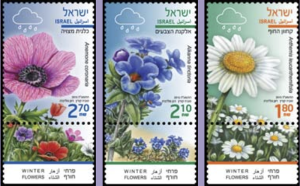These stamps will be issued February 10th.
[from Israel Post]
 Most of Israel’s wild flowers bloom in spring, the soil is moist from the winter rains and temperatures are warm.
Most of Israel’s wild flowers bloom in spring, the soil is moist from the winter rains and temperatures are warm.
However, some of Israel’s wild flowers bloom much earlier during the growth season. Such are the well known Sternbergia and Autumn Crocus (Colchicum) which bloom in fall; and quite a number of flowers bloom at the height of winter, when the weather is cold and rainy. Most autumn flowers are sparse or bloom in small patches, while the early winter flowers normally form spectacular blooming carpets. Their short growth season enables them to bloom several weeks after the first rains of the season in mid-winter. The early blooming helps these flowers avoid competition for resources – water and soil nutrients, light, and especially pollination services (mostly by insects such as bees and beetles), as opposed to spring blooming flowers.
Early blooming is typical to relatively arid areas such as sandy areas of the Coastal Plain, and the Northern Negev, where the soil dries early, so early blooming is an advantage.
Coast False-Chamomile (Anthemis leucanthemifolia)
This semi-recumbent annual plant forms spectacular blooming carpets on the coastal sand fields as early as January. Unlike other species of False-Chamomile of Israel, it has succulent leaves which are wedge-shaped, and not pinnate; and the inflorescences are relatively large and dense.
The False-Chamomile species belong to the Daisy family, which is characterized by its flower-like inflorescences. It has many white flowers which look like petals, arranged in the outer circle of the inflorescence and numerous yellow flowers in the center which resemble stamens. The inflorescence appears to pollinating insects to be a flower (as it does to humans).
The Coast False-Chamomile is endemic to the coastal plains of Israel and Southern Lebanon, and grows nowhere else in the world.
Dyer’s Alkanet (Alkanna tinctoria)
This recumbent perennial plant is covered with rough bristles, as are many other plants belonging to the Borage family. During much of the year the Alkanet is a dull looking plant, but in winter and early spring it displays a profusion of bright blue flowers.
The root coat of Dyer’s Alkanet is red and was used in the past to produce a red dye. When rubbed on paper, it dyes the paper bright red. The plant’s scientific name stems from this: Alkanna is the Latin form of the Arabic word “Al- Hinna” – the general term for yellow-red dyes produced from plants. The word tinctoria means “of the dyers”.
Crown Anemone (Anemone coronaria)
Everyone in Israel knows the Crown Anemone, one of Israel’s most beautiful wild flowers. The Hebrew name “Kalanit” is derived from the same source as the word for bride – “Kala”. Crown Anemones bloom from early winter through the end of spring, forming magnificent flowering carpets.
The red variety of the Crown Anemone grows through much of the country, while the multicolored variety, in colors ranging from white to deep purple through all shades of pink and blue, grows mainly in the north. The multi-colored variety is sensitive to lime, and thus is rare in lime-rich soils. It is abundant mainly in the basaltic soils of the eastern Galilee and the Golan, and in the deep soils of the northern valleys. The red variety which grows through much of the country is drought-hardy and creates blazing flowering fields in the south.
—Hagar Leschner
Collection Manager of the National Herbarium, The Hebrew University of Jerusalem



